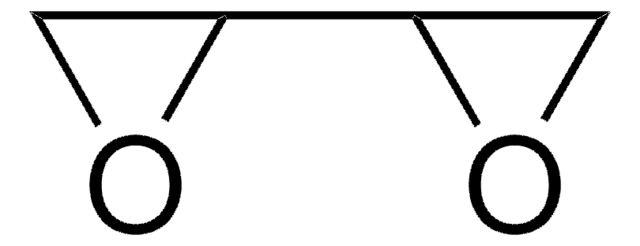220892
Éther diglycidylique de 1,4-butanédiol
≥95%
Synonyme(s) :
1,4-Bis(2,3-epoxypropyloxy)butane
About This Item
Produits recommandés
Pression de vapeur
~10 mmHg ( 20 °C)
Niveau de qualité
Essai
≥95%
Forme
liquid
Indice de réfraction
n20/D 1.453 (lit.)
pb
266 °C (lit.)
Densité
1.1 g/mL at 25 °C (lit.)
Chaîne SMILES
C(CCOCC1CO1)COCC2CO2
InChI
1S/C10H18O4/c1(3-11-5-9-7-13-9)2-4-12-6-10-8-14-10/h9-10H,1-8H2
Clé InChI
SHKUUQIDMUMQQK-UHFFFAOYSA-N
Vous recherchez des produits similaires ? Visite Guide de comparaison des produits
Catégories apparentées
Description générale
Application
- for preparing amylose, xylan and hydroxyethyl-cellulose
- to cross link polyethylenimine which also serves as a hole-blocking layer in organic solar cells
- to cross link hyaluronic acid into hydrogels
- for the activation of soluble dextran polymers.
- Amine or hydroxyl containing bis-epoxy supports are reacted with BDDE to form particles containing terminal epoxide group for immobilization reactions.
Mention d'avertissement
Danger
Mentions de danger
Classification des risques
Acute Tox. 4 Dermal - Acute Tox. 4 Inhalation - Acute Tox. 4 Oral - Aquatic Chronic 3 - Eye Dam. 1 - Skin Irrit. 2 - Skin Sens. 1
Code de la classe de stockage
10 - Combustible liquids
Classe de danger pour l'eau (WGK)
WGK 2
Point d'éclair (°F)
235.4 °F - closed cup
Point d'éclair (°C)
113 °C - closed cup
Équipement de protection individuelle
Eyeshields, Faceshields, Gloves, type ABEK (EN14387) respirator filter
Faites votre choix parmi les versions les plus récentes :
Déjà en possession de ce produit ?
Retrouvez la documentation relative aux produits que vous avez récemment achetés dans la Bibliothèque de documents.
Global Trade Item Number
| Référence | GTIN |
|---|---|
| 220892-250G | 4061838776730 |
| 220892-10G | 4061838776723 |
| 220892-1KG | |
| 220892-5KG | |
| 220892-50G | 4061838776747 |
Notre équipe de scientifiques dispose d'une expérience dans tous les secteurs de la recherche, notamment en sciences de la vie, science des matériaux, synthèse chimique, chromatographie, analyse et dans de nombreux autres domaines..
Contacter notre Service technique










